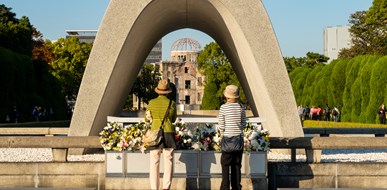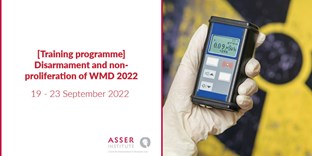[Nuclear disarmament] Thea Coventry: ‘Codifying legal norms might not prevent nuclear war, but it does help to create a world where nuclear weapons are unthinkable’
Published 25 August 2022By Jasper Schellekens and Pascal Messer

iStock - The Hiroshima Victims Memorial Cenotaph with a view of Atomic Bomb Dome by Aleksandra Tokarz
While war is threatening the Russian-controlled Zaporizhzhia Nuclear Power Plant in Ukraine, representatives of nearly two hundred states are meeting at the United Nations in New York to review the Treaty on the Non-Proliferation of Nuclear Weapons. We asked Thea Coventry, researcher in International Arms Control Law, why this particular 10th NPT Review Conference is so important for the future of nuclear disarmament. Coventry: “If there is no consensus document by the end of this conference, then we have no shared path to disarmament. Given the current geopolitical landscape, that's not a good path to be on.” An interview.
Earlier this month, at the opening of the 10th NPT Review Conference in New York, ‘U.N. nuclear chief’ Rafael Grossi warned that the situation surrounding Europe’s largest nuclear power plant in Ukraine was “completely out of control”. He urged Russia and Ukraine to quickly allow experts to visit the plant and stabilise the situation to avoid a nuclear accident.
Grossi also called for states to ‘come together in this moment of global uncertainty, anxiety, fear and distress’ and to recommit to the ‘noble principles’ enshrined in the Treaty on the Non-Proliferation of Nuclear Weapons (NPT).
The objective of this landmark international treaty, also known as the ‘Non-Proliferation Treaty’ or simply the ‘NPT’, is to prevent the spread of nuclear weapons and weapons technology and to promote cooperation in the peaceful uses of nuclear energy. Ultimately the treaty aims to further the goal of achieving complete nuclear disarmament.
Near universal membership
The NPT is an important treaty that came into force in 1970. Its unique status is based on its near universal membership with legally-binding obligations on disarmament. The treaty also establishes the International Atomic Energy Agency (IAEA) as the agency responsible for the verification safeguards system. More countries have ratified the NPT than any other arms limitation treaty or disarmament agreement, with 191 states having joined, including the five nuclear-weapons states China, France, Russia, United Kingdom, and the United States
Every five years, the NPT’s operation is reviewed during a so-called Review Conference. This conference usually ends with a final declaration on the progress made. It also contains recommendations to further strengthen the treaty’s provisions. Due to the Covid-19 pandemic, however, the last NPT Review Conference was postponed by two years. Earlier this month, the 10th NPT Review Conference finally started, seven years since the last review in 2015. However, since 2015, the international landscape has changed quite a bit, according to Thea Coventry, researcher in International Arms Control Law at the Asser Institute.
The 10th NPT Review Conference is currently ongoing in New York. Why is it important?
Thea Coventry: “This edition is really important on the path towards a nuclear-free future. Major issues are the failure to bring the Comprehensive Nuclear Test Ban Treaty into force, which is one of the other treaties in the in the nuclear disarmament regime. Another issue is the failure to establish a ‘weapons of mass destruction free zone’ in the Middle East. Given the build-up of Iranian capabilities and the ongoing conflicts in the region, that is a problem. It is also important because the last Review Conference in 2015 was generally perceived to be a failure. That conference did not produce a consensus document on how to move toward disarmament, meaning that in the past seven years, state parties have had no shared action plan for disarmament. We all know that since 2015, a lot of key developments have happened, so if there is no consensus document with a plan to move to disarmament by the end of the 10-th Review Conference, then we have no shared path to disarmament. Given the current geopolitical landscape, that's not a good path to be on.”
What are the major changes in the nuclear disarmament landscape in the last seven years?
“There have been three important changes. First and foremost, of course, there’s the war in Ukraine, with Putin actively threatening to use nuclear weapons and the Russian occupation of the nuclear power plant Zaporizhzhia as a strategic military move. This is, I think, the most concerning development.
Then we have, in the past seven years, seen a general increase in global instability. There has been no tangible move from any of the nuclear weapon states to move toward complete disarmament. And China and the United Kingdom are actually building up and modernising their nuclear weapons.
There has actually been a breakdown of cooperation between nuclear states and several nuclear agreements have been discarded. Think of the 1987 INF Treaty on Intermediate-Range Nuclear Forces, the Conventional Forces in Europe Treaty and the 2002 Open Skies Treaty, a programme of allowing for unarmed aerial surveillance flights over the territory of its participants.
It was the Trump administration in the United States that pulled out of all three treaties, referring to Russia’s non-compliance. While the Russian government certainly conducted activities that were not compliant – such as developing and deploying a prohibited cruise missile, for instance – I think that both states could have looked for alternative mechanisms to resolve this issue. Fortunately, US president Biden and the new administration have taken a much more conciliatory approach and have recently renewed the New Start Agreement.
Catastrophic humanitarian consequences
Another important development is the ‘shift to humanitarianism’ in the nuclear disarmament movement itself. In 2010, state parties to the NPT treaty expressed their concern about the catastrophic humanitarian consequences of the use of nuclear weapons, and they mandated all states to comply with international law. We all know about the devastating effects of the atomic bombings of Hiroshima and Nagasaki, but nuclear weapons also pose a long-term threat to human health, the environment, infrastructure, social economic development, and food security, amongst others.
Around 2009, these catastrophic humanitarian consequences started to gain renewed attention. In 2009, for instance the then US president Barack Obama spoke in Prague of the continued dangers of nuclear weapons, and of the future of nuclear weapons in the 21st century. The outcome document of the 2010 NPT Review Conference also had a statement of concern.
Around that time, a group of non-nuclear states organised three conferences - coordinated largely by the International Campaign to Abolish Nuclear Weapons (ICAN) - on the topic of the humanitarian impact of nuclear weapons. And this eventually led to the creation of the 2017 Treaty on the Prohibition of Nuclear Weapons (TPNW). That is a pretty major development in the field: a whole new treaty, one that already has 86 states parties which had their first meeting in June 2022, right before the 10th Review Conference started.
Driven by civil society
What is interesting, is that the Treaty On the Prohibition of Nuclear Weapons was mainly driven by civil society, and ICAN was awarded the Nobel Peace Prize in 2017 for their work on this treaty. Rebecca Eleanor Johnson, president of ICAN at the time (who will be speaking at our doctoral seminar next month), was instrumental in this process.
What I find fascinating, is that several non-party states - such as Germany, Norway and Australia - have already attended the meeting of the TPNW as observers, because they’ve also been frustrated about the slow process towards disarmament. This shows that despite pressure from the United States on NATO member states to reject the Prohibition treaty, it is actually gaining momentum because of the frustration among the non-nuclear weapon states. This is likely to change the dynamic at the Review Conference. It will provide a point for the non-nuclear weapons states to rally around and press harder for a greater commitment to disarmament.”
We interviewed your colleague, the Arms Control Law expert Thilo Marauhn earlier this year, and he emphasised that part of the importance of treaties like the NPT is to provide a framework for dialogue.
“I think it is true that the Review Conference creates a forum to discuss issues and move forward. While it was totally unforeseen that the capture of Zaporizhzhia nuclear power plant would be an issue of discussion at the current Review Conference, the conference now indeed provides an important space for states to try and put pressure on Russia to stop using the nuclear power plant for military operations.
While it was totally unforeseen that the capture of Zaporizhzhia nuclear power plant would be an issue of discussion at the current Review Conference, the conference now indeed provides an important space for states to try and put pressure on Russia to stop using the nuclear power plant for military operations.
In fact, a lot of the existing nuclear agreements are designed to facilitate dialogue, build confidence and create transparency. The Open Skies Treaty 2002, for example, allows states to make certain flights to check the weapons and measures of the other states that have signed the treaty. Although this didn't result in any actual strategic advantage - as states already had sufficient technology to monitor these weapons – this was simply a confidence-building measure. The new Treaty on the Prohibition of Nuclear Weapons - with its outright prohibition of nuclear weapons - has a similar role as well. It is trying to shift the dialogue.”
Does the Treaty on the Prohibition of Nuclear Weapons weaken the influence of the NPT treaty?
“The Treaty on the Non-Proliferation of Nuclear Weapons (NPT) was drafted in 1967, at the height of the Cold War, so it has been in place for over fifty years. However, the nuclear weapon states have not yet fulfilled their promise to disarm. The non-nuclear weapon states, on the other hand, have fulfilled their obligations. They haven't received nuclear weapons, they haven’t developed nuclear weapons, so the NPT treaty been a somewhat one-sided treaty.
What the 2017 Treaty on the Prohibition of Nuclear Weapons has done, is shift the central norm from one of just interstate control to a broader focus on human value. And that is a shift you can see more generally in international law, with greater recognition of individuals, or animals, or climate, and more. At the current 10th Review Conference, a lot of non-nuclear weapon states are now demanding that the five nuclear weapon states make good on their Article 6 promises to disarm. So I think that the TPNW calling for a complete ban on nuclear weapons, has been a good strategic move to try and elevate the prohibition norm within the NPT treaty.”
Technology has developed quite rapidly in these last seven years. Does emerging technologies’ impact on nuclear weapons play a role at the 10th Review Conference?
“That is indeed an important debate at the moment. Technology is changing rapidly, and it is now even changing the way that we define a ‘weapon’. So, can we still use these descriptive treaties? Or will treaties have to become broader in their codification of norms? Or do we perhaps need a totally different model? These are questions that need to be answered, as we will need to set up mechanisms that are future-proof. The focus would need to be on confidence-building and transparency, because that's how we reduce conflict.”
There has been debate as to the effectiveness of treaties. Do you think the NPT has been effective?
“As I have said before, in the area of nuclear disarmament, the NPT cannot claim to be very successful, as no nuclear state has fulfilled its promise to disarm. However, as we’ve seen, treaties do not stand on their own. Every single action plays a part in achieving and maintaining a nuclear-free future, as the Treaty on the Prohibition of Nuclear Weapons has shown. While codifying legal norms does not necessarily prevent nuclear war, it does work towards creating a world where the development, possession and use of nuclear weapons is unthinkable.”
Update Monday 29-08-2022
As Thea Coventry feared might happen at the time of this interview, the 10th NPT Review Conference has, after four weeks of intense negotiations, ended without a consensus document. As Russia refused to accept the final version of the consensus document, there is no agreement on the path forward to disarmament within the framework of the Nuclear Non-Proliferation Treaty. Thea Coventry:
“Russia’s blocking of the weakened version of the final consensus document is disappointing and it is a big blow to the future of NPT. The silver lining, however, is the safety around the Zaporizhzhia power plant, Ukraine’s and Europe’s largest nuclear facility. The good news is that inspectors from the International Atomic Energy Agency (IAEA) are being sent to protect the safety and security next week. This was a priority for the participating states and a core topic of discussion at the meeting."
“The failure to achieve consensus at the 10th Review Conference, only stresses the importance of the Treaty on the Prohibition of Nuclear Weapons, as this is the alternative legal framework for states to continue implementing the nuclear disarmament obligations of the NPT.”
Thea Coventry
Thea Coventry forms part of the ‘Regulation in the public interest: disruptive technologies in peace and security’ strand of research. Thea is completing her PhD (Leiden University) investigating the role of accidental and strategic textual ambiguity in the progressive development and codification of legal rules in the field of State criminal jurisdiction. Her research interests include international arms control law, maritime security, and transnational criminal law.
Critical knowledge for contemporary diplomacy: Advance your knowledge on the impact of Weapons of Mass Destruction
The challenges posed to international security by nuclear, chemical, and biological weapons have recently reached levels of urgency not seen since the Cold War. There is an increasing demand for professionals in the field of Weapons of Mass Destruction (WMD) to tackle the challenges of today’s non-proliferation and disarmament agenda with a more integrated understanding of these issues. From 19 to 23 September, the Asser Institute in The Hague will host the thirteenth training programme on disarmament and non-proliferation of weapons of mass destruction, co-organised with the Organisation for the Prohibition of Chemical Weapons (OPCW). Register now.
Training tomorrow's leading experts in disarmament and non-proliferation: Doctoral seminar on nuclear weapons
Early career researchers in disarmament and non-proliferation are invited to join us at the Asser Institute in The Hague for the second 2022 arms control seminar. This doctoral seminar is focused on the topic of nuclear weapons. Receive guidance from leading academics and practitioners, invaluable feedback on your research and seize the opportunity to build your international network. Register now.
Read more about arms control
- Barry de Vries and Thilo Marauhn. Not a love affair: The relationship between the Treaty on the Prohibition of Nuclear Weapons and the Nuclear Non-Proliferation Treaty (2020).
- Geir Ulfstein, Thilo Marauhn and Andreas Zimmermann. Making Treaties Work: Human Rights, Environment and Arms Control (2007).


